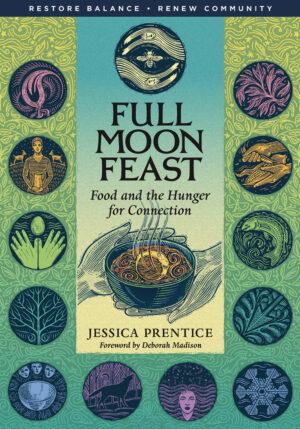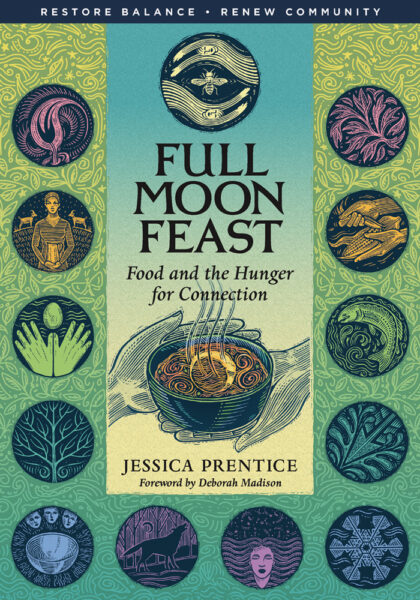Make Your Own Root Beer: Celebrate the Wort Moon!

Much of what we know about the moon consists of when it’s waning, when it’s waxing, and that a full moon makes people do strange things.
And while it’s common knowledge (and not just on cheesy astrology websites) we have a connection to the moon, it’s hard to know exactly what it is, without sounding a bit like your crazy aunt who wears flowing glittery jumpsuits and calls herself by a Sanskrit nickname.
But the moon is a dynamic and energetic force — especially when it comes to food.
Jessica Prentice, longtime chef and passionate food activist–not to mention the inventor of the word “locavore”–talks about the thirteen lunar cycles of an agrarian year, from the midwinter Hunger Moon and the springtime sweetness of the Sap Moon to the bounty of the Moon When Salmon Return to Earth in autumn.
And now that it’s late summer, it means we’re living under the Wort Moon. The moon of making your own root beer.
The following is an excerpt from Full Moon Feast: Food and the Hunger for Connection by Jessica Prentice.
If they would eat nettles in March,
and drink mugwort in May,
so many fine maidens would not go to the clay.
—Funeral song of a Scottish mermaid
In late summer we enter the lunar phase known in sixteenth century England as the Wort Moon. Wort is a wonderfully old fashioned Old English word that has fallen into disuse, one that the dictionary calls “archaic.” Yet it is a word that beckons to me from history, a word that wants to be remembered.
The first definition for wort in the Oxford English Dictionary is “a plant, herb, or vegetable used for food or medicine; often = a potherb.”
As early as 1605 the word wort was being replaced by the word herb, as is shown in a quote from that year: “Woortes, for which wee now vse the French name of herbes….”
The word was still understood and used occasionally throughout the next centuries. In 1864: “We find the healing power of worts spoken of as a thing of course.” A love poem written in 1888 includes the delectable tidbit: “And worts and pansies there which grew / Have secrets others wish they knew.”
The original meaning of wort survives to this day in the names of many of our medicinal herbs.
Saint-John’s-wort, still widely used today, is a beautiful yellow plant that was traditionally harvested on Saint John’s Day—which falls near the summer solstice.
Many other medicinal herbs incorporate the word wort in their names, including lungwort, mugwort, motherwort, gipsywort, soapwort, masterwort, Indian birthwort, figwort, rupturewort, bairnwort, banewort, bloodwort, bridewort, cankerwort, clown’s woundwort, coughwort, feverwort, fleawort, glasswort, and dozens of others.
In some cases the name gives a clue to how the herb is used: Lungwort makes a mucilaginous tea that soothes coughs; soapwort root is loaded with saponins, and is used in treating skin problems. But in others it can be misleading: Fleawort is so named not because it wards off fleas or cures fleabites, but because the seeds look like fleas!
The names of herbs possess much poetry. I also hear in their names a kind of ancestral memory— an ancient wisdom that wants to be remembered.
The plants seem to be calling to me through their names. They remind me that once upon a time they were honored and valued; they were the primary source of healing. The herbs themselves and the gardens they grew in were our medicine chests, instead of today’s brand-named plastic bottles filled with pharmaceutical pills.
Herbs were a part of daily life—a familiar, everyday, working knowledge— just as aspirin and vitamin C are to us today. The World Health Organization recently estimated that 80 percent of the world’s population still relies on botanical medicine for a majority of health problems.
I find that statistic a potent reminder of how important plants are in treating illness.
I must admit that I have had my skeptical moments about the healing power of herbs. I have been dubious that the leaves of a certain plant could really cure a cough, or that the flowers of another could treat depression, or that the root of still one more could clear up the skin.
Plants seem like such mild, simple, common things to have such powers.
But everyone who was at my thirtieth birthday party and anyone else who has ever smoked marijuana knows that a plant can have a very powerful effect. So does anyone who’s ever gotten poison oak or poison ivy. And of course we all know that certain plants can be fatal if eaten.
So whenever I find myself doubting the power of plants, I remember that if plants can make us hallucinate, or make us itch like crazy, or kill us, it is only logical that they can heal us as well.
Root Beer
Makes 2 quarts
This is one of the few traditional lacto-fermented beverages modern people are familiar with—though the modern version is little like the traditional. For one thing, it is now illegal to sell root beer made from sassafras.
Even though sassafras was a traditional herb long used by the peoples indigenous to southeastern North America, science experiments injecting large amounts of safrole—a compound in sassafras—into lab rats gave the animals cancer.
But any compound, taken out of its plant matrix and injected in high quantities, can be toxic. Some people smell a rat: soft drink companies wanting to eliminate competition from home brewers?
I make my root beer from sassafras—traditionally used as a blood cleanser—and don’t fret about the trace amounts of safrole it contains.
- 2 tablespoons dried sassafras (the bark of the root), available at herb stores or online
- 1 tablespoon dried licorice root, available at herb stores or online
- 2 quarts filtered water
- 1/3 cup birch syrup
- 1/3 cup Sucanat or Rapadura
- 1 cup ginger bug, 1/2 cup kefir grains, or 1 cup yogurt whey
Put the sassafras and licorice in a large pot and pour 1 quart of the filtered water over it.
Bring to a simmer and cover for 20 minutes. Turn off the heat and leave covered for about half an hour.
Pour the birch syrup and Sucanat or Rapadura into a 2-quart mason jar, and strain the still-hot herbal mixture over the birch syrup. Stir or whisk to dissolve.
Add the remaining 1 quart of filtered water. Stir to combine.
Touch the liquid with your finger or use a milk thermometer to gauge the temperature.
Before you add the ginger bug, kefir grains, or whey, the liquid needs to cool to about 100º F. This was the temperature the alewife would call blood warm. It should feel just warm to the touch but not hot.
Add the ginger bug, kefir grains, or whey, screw on the lid, and leave for 2 to 4 days in a warm place.
Strain equal amounts into two glass bottles with screw tops.
I use the bottles from Gerolsteiner mineral water. If they are 1-quart bottles, they should be full; if they are 1-liter bottles, add enough water to fill. Screw the lids on tightly, label and date the bottles, and return to the warm place for another 2 to 3 days.
Transfer to the fridge. Once they are cold you can enjoy them anytime!
When you are ready to drink the root beer, open the bottles carefully because they may have built up a lot of carbonation. Open them outside or over a sink. Turn the lid very slowly to see if the drink begins to release foam.
If so, then allow it to release some of the carbon dioxide by not opening the bottle all the way and letting out some of the pressure, then opening it more and more, bit by bit. This way you won’t lose your drink to its carbonation.
Recommended Reads
Recent Articles
Oh, honeysuckle…how we love thee. If only there was a way to capture the sweet essence of this plant so we could enjoy it more than just in passing. Luckily, foraging and some preparation can help make that happen! Here’s a springtime recipe that tastes exactly like honeysuckle smells. The following excerpt is from Forage,…
Read MoreIntroducing…your new favorite brunch dish! This whole broccoli frittata is packed with fresh, wildcrafted flavors that are bound to help you start your day off on the right foot. The following is an excerpt from The Forager Chef’s Book of Flora by Alan Bergo. It has been adapted for the web. RECIPE: Whole Broccoli Frittata…
Read MoreWondering where to forage for greens this spring? Look no further than hedges, which serve as natural havens for wild greens and herbs! The following is an excerpt from Hedgelands by Christopher Hart. It has been adapted for the web. Food from Hedges: Salads and Greens Let’s start by looking at all the wild foods…
Read MoreThere’s a whole new world out there when it comes to koji. It doesn’t matter if you’re making bread, cheese, or ice cream, koji helps you pump up the flavor! Growing Koji in Your Own Kitchen Koji, the microbe behind the delicious, umami flavors of soy sauce, miso, fermented bean sauce, and so many of…
Read MoreWhether you’re looking to replace your end-of-the-day cocktail, relax before bed, or want something new to add to your tea, this non-alcoholic mocktail syrup base will do the trick. Delicious and all-natural, take a sip of this nightcap mocktail and feel your troubles melt away. The following is an excerpt from Herbal Formularies for Health…
Read More









